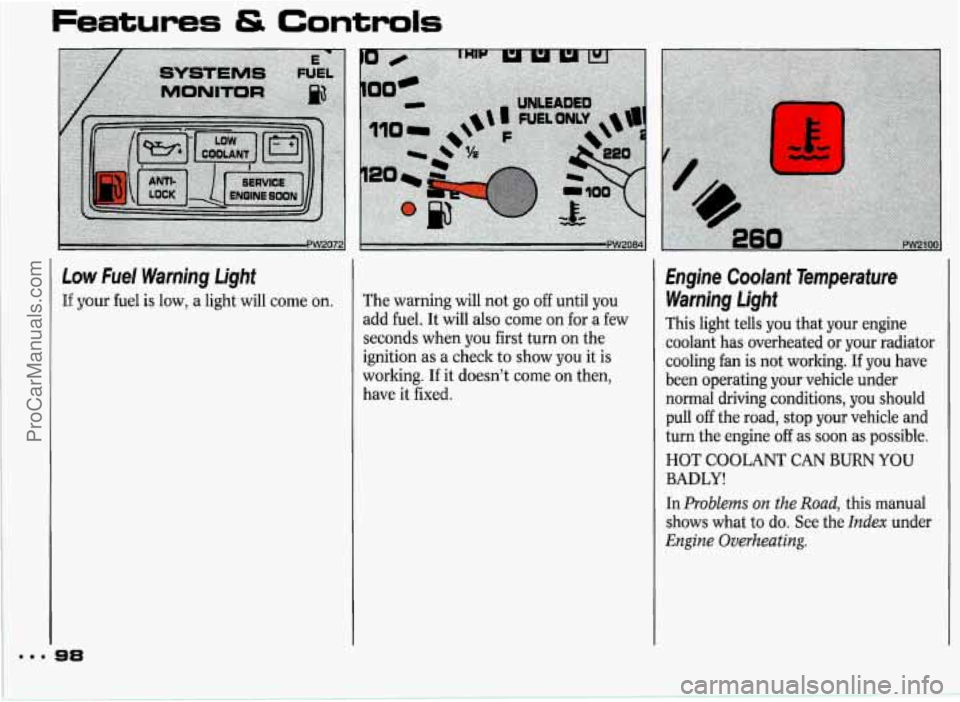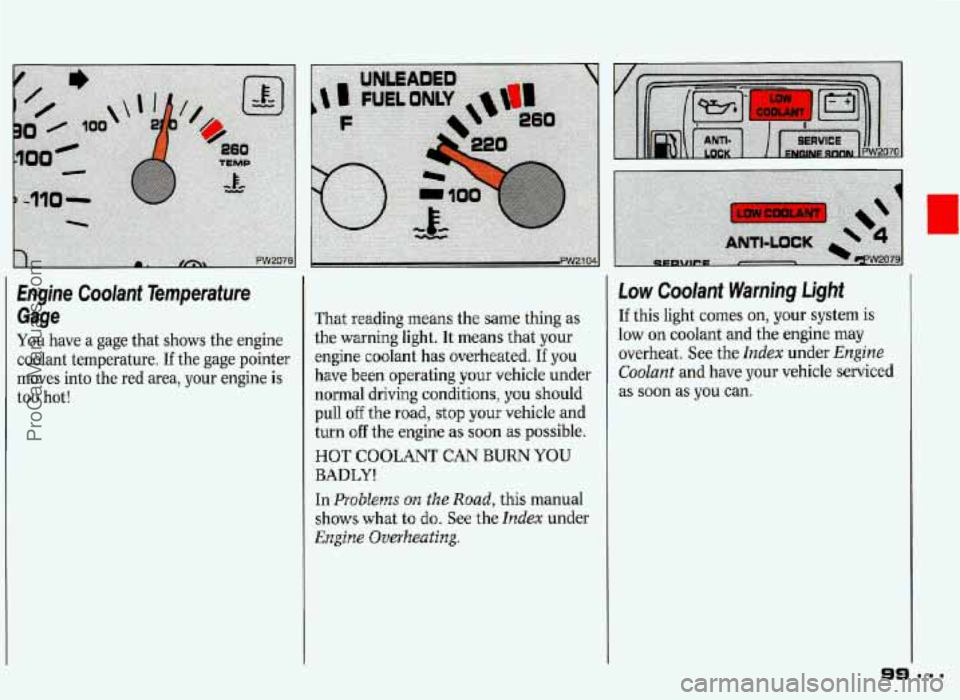1993 PONTIAC GRAND-PRIX engine overheat
[x] Cancel search: engine overheatPage 4 of 338

How to Use this Manual
b
Using Your 1993 Pontiac Owner’s
Manual
Many people read their owner’s manual
from beginning to end when they first
receive their new vehicle. This will help
you learn about the features and
controls for your vehicle. In this manual,
you’ll find that pictures and words work
together to explain things quicltly.
There are nine parts with color-tabbed pages in this manual. Each part begins
with a brief list of contents,
so you can
usually tell at a glance if that part
contains the information you want.
You can bend the manual slightly to
reveal the color tabs that help you find a
part.
Part 1: Seats & Safety Belts
This part tells you how to use your seat:
and safety belts properly.
Part 2: Features 8z Controls
This part explains how to start and
operate your Pontiac.
Part 3: Comfort Controls & Audio
Systems
This part tells you how to adjust the
ventilation
and comfort controls and
how to operate your audio system.
Part 4: Your Driving and the Road
Here you’ll find helpful information anc
tips about the road and how to drive
under different conditions.
Part 5: Problems on the Road
This part tells you what to do if you
have a problem while driving, such as a
flat tire or engine overheating.
Part 6: Service & Appearance Care
Here the manual tells you how to keep
your Pontiac running properly and
looking good.
Part 7: Maintenance Schedule
This part tells you when to perform
vehicle maintenance and what fluids
and lubricants to use.
Part 8: Customer Assistance
Information
This part tells you how to contact
Pontiac for assistance and how
to get
service publications. It also gives you
information on
Reporting Safety
Defects.
Part 9: Index
Here’s an alphabetical listing of almost
every subject in this manual.
You can
use it to quicltly find something
you
want to read.
Service Station Information
This is a quick reference of service
information.
You can find it on the last
page of this manual.
~~.
ProCarManuals.com
Page 57 of 338

If you drive too quickly through I
deep puddles or standing water,
water can come in through your
engine’s air intake and badly
damage your engine. If you can
avoid deep puddles or standin
water, dr&e through them ve
Engine Block Heater (OPTION)
In very cold weather, 0°F (-18°C) or
colder, the engine block heater can
help. You’ll get easier starting and
better fuel economy during engine
warm-up.
To Use the Block Heater:
1. Turn off the engine.
2. Open the hood and unwrap the
3. Plug it into a normal, grounded
electrical cord.
110-volt outlet.
Plugging the cord into an
ungrounded outlet could
cause an electrical shock.
Also, the
wrong kind
of extension cord could
overheat and cause a fire. You
could be seriously injured. Plug the
cord into a properly grounded
three-prong
1 10-volt outlet. If the
cord won’t reach, use a heavy-duty
three-prong extension cord rated
for at least 15 amps.
NOTICE
After you’ve used the block heater,
be sure to store the cord as it was
before, to keep it away from
moving engine parts.
If you dol
it could be damaged. .
.,.~~,~..~~~,~.= -~ -..= ~,,“~~,-~,~~=~~.-~,~-, F,I,,,i ,... ~~
How long should you keep the block
heater plugged in? The answer depends
on the weather, the kind of oil you have,
and some other things. Instead
of trying
to list everything here, we ask that you
contact a Pontiac dealer in the area
where you’ll be parking your vehicle.
The dealer can give you the best advice
for that particular area.
ProCarManuals.com
Page 65 of 338

Features & Controls
I CAUTION
A If you skip more than one
L A gear when you downshift,
you could lose control of your
vehicle. And you could injure
yourself or others. Don’t shift from
5 tn 2 nr 4 tn 7.
If you skip nwrt: ~11arl one gear
when you downshift,
or if you race
the engine when you downshift,
you can damage the clutch nr
transaxle.
1
Pump-to-Set Parking Brake
The parking brake uses the brakes on
the rear wheels.
To Set the Parking Brake:
Hold the regular brake pedal down with
your right foot. Pump your parking
brake pedal several times with your left
foot until the pedal feels firm.
If the
ignition is
on, the brake system warning
light will come on.
Over time, more
pumps may be needed
to set the parking brake firmly. If it ever
takes more than two full pumps, have
the brake system adjusted by your
dealer.
To Release the Parking Brake:
Hold the regular brake pedal down. Pull
the
BRAKE RELEASE lever.
Driving with the parKing DraKe
on
can cause your rear brakes to
overheat. You may have to replace
them, and you could also damage
other parts of your vehicle.
ProCarManuals.com
Page 68 of 338

Leaving Your Vehicle With the
Engine Running
(AUTOMATIC TRANSAXLE)
It is dangerous to leave your
vehicle with the engine
running. Your vehicle could move suddenly
if the shift lever is not
fully in P (Park) with the parking
brake firmly set. And, if you leave
the vehicle with the engine running,
it could overheat and even catch
fire.
You or others could be injured.
Don't leave your vehicle with the
engine running unless
you have to.
If you have to leave your vehicle with
the engine running, be sure
your vehicle
is in P (Park) and your parking brake is
firmly set before you leave it. After
you've moved
the shift lever into the
P (Park) position, hold tbe regular
bralre pedal down. Then, see
if you can
move the shift lever away from P (Park)
without first
pulling it toward you (or, if
you have the console shift lever,
without first pushing the button).
If you
can, it means that the shift lever wasn't
hlPy locke'd into P (Park).
Parking Your Vehick
(MANUAL TRdNSAXLE)
Before you get out of your vehicle,. put
your manual transaxle in R (Reverse)
and firmly apply the parking brake.
If
you are parking on a hill, see the
Index under Parking an Mills.
ProCarManuals.com
Page 99 of 338

8..
Features & Controls
Low Fuel Warning Light
If your fuel is low, a light will come on.
98
The warning will not go off until you
add fuel. It will also come on for a few
seconds when
you first turn on the
ignition as a check to show you it is
working. If it doesn’t come on then,
have it fixed.
Engine Coolant Temperature Warning Light
This light tells you that your engine
coolant has overheated or your radiator
cooling fan is not working. If you have
been operating your vehicle under
normal driving conditions, you should
pull off the road, stop your vehicle and
turn the engine off
as soon as possible.
HOT
COOLANT CAN BURN YOU
BADLY!
In Problems on the Road, this manual
shows what to do.
See the Index under
Engine Overheating.
ProCarManuals.com
Page 100 of 338

Engine Coolant Temperature Gage
You have a gage that shows the engine
coolant temperature.
If the gage pointer
moves into the red area, your engine
is
too hot! That
reading means the same thing as
the warning light.
It means that your
engine coolant
has overheated. If you
have
been operating your vehicle under
normal driving conditions, you should
pull
off the road, stop your vehicle and
turn
off the engine as soon as possible.
HOT COOLANT CAN BURN YOU
BADLY!
In Problems on the Road, this manual
shows what to
do. See the Index under
Engine Overheating.
Low Coolant Warning Light
If this light comes on, your system is
low on coolant and the engine may
overheat. See the
Index under Engine
Coolant and have your vehicle serviced
as soon as you can.
ProCarManuals.com
Page 148 of 338

‘Riding” your brakes can
:ause them to overheat to t
point that they won’t work well.
You might not be able to stop your
vehicle in time to avoid an accident.
If you “ride” your brakes, they will
get
so hot they will require a lot of
pedal force to slow you
&--
Avoid “riding” the brake-. 3
I’
rs wears them 1 ”)- 2.’;
out much faster. You would need 253
costly brake replacement much 35
sooner than normal, and it also ?$:
.,,&
,,.7.. d:$
/P ,=;.;>,:
If you keep pace with the traffic and
allow realistic following distances, you
will eliminate a lot of unnecessary
braking. That means better braking and
longer brake life.
If your engine ever stops while you’re
driving, brake normally but don’t
pump your brakes. If you do, the
pedal may get harder to push down. If
your engine stops, you will still have
some power brake assist. But you will
use it when you brake. Once the
power assist is used up, it may take
longer to stop and the brake pedal will
be harder to push.
Anti-Lock Brakes (ABS) (OPTION)
If your Pontiac has this system, it has an
advanced electronic braking system
that
will help prevent skidding.
If you have an anti-lock brake system
(ABS), the brake pedal will say so.
ProCarManuals.com
Page 181 of 338

Your Driving and the Road
Driving with a Trailer (CONT.)
Making Turns
When you’re turning with a trailer,
make wider turns than normal. Do this
so your trailer won’t strike soft
sh’oulders, curbs, road signs, trees, or
other objects. Avoid jerky or sudden
maneuvers. Signal well in advance.
Turn Signals When Towing a Trailer
When you tow a trailer, your vehicle has
to have a different turn signal flasher
and extra wiring. The green arrows on
your instrument panel will flash
whenever you signal
a turn or lane
change. Properly hooked
up, the trailer
lights will also flash, telling other
drivers you’re about to turn, change
lanes or stop.
When towing a trailer, the green arrows
on your instrument panel will flash for
turns even if the bulbs on the trailer are
burned out. Thus, you may think
drivers behind you are seeing your
signal when they are not.
It’s important
to check occasionally
to be sure the
trailer bulbs are still working.
Your vehicle has bulb warning lights.
When you plug trailer lights into your
vehicle’s lighting system, its bulb
warning lights may not let you know if
one of your lights goes out.
So, when
you have trailer lights plugged in, be
sure
to check your vehicle and trailer
lights
from time to time to be sure
they’re all working. Once
you
disconnect the trailer lights, the bulb
warning lights again can tell you if one
of your vehicle lights is out.
Driving On Grades
Reduce speed and shift to a lower gear
before you start down a long or steep
downgrade.
If you don’t shift down, you
might have to use your brakes so much
that they would get hot and
no longer
work well.
On a long uphill grade, shift down and
reduce your speed to around
45 mph
(70 kwh) to reduce the possibility of
engine and transaxle overheating.
If you are towing a trailer and you have
an automatic transaxle with Overdrive,
it’s best to drive in
D instead of (or
as you need to, a lower gear). This will
minimize heat build-up and extend the
life of your transaxle.
ProCarManuals.com